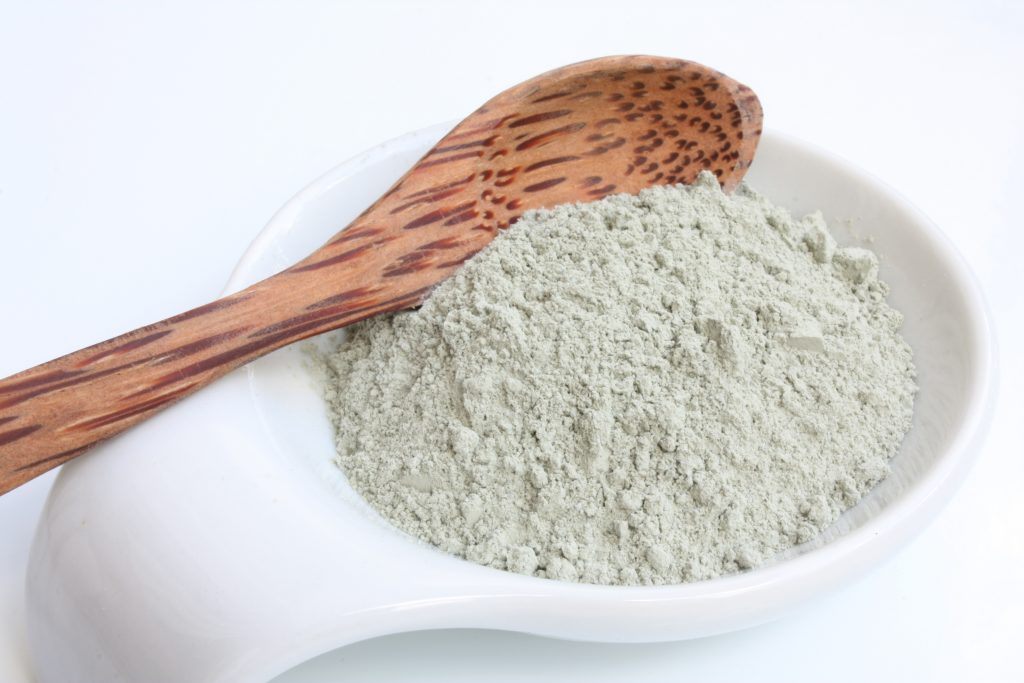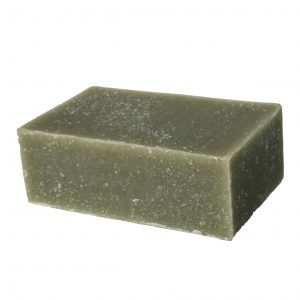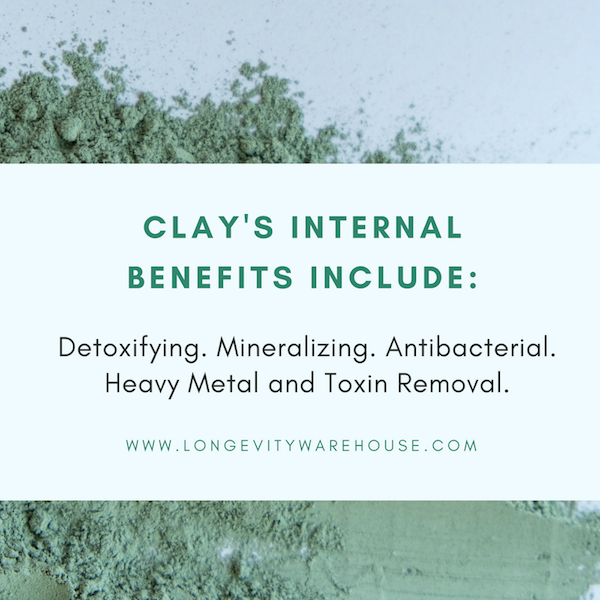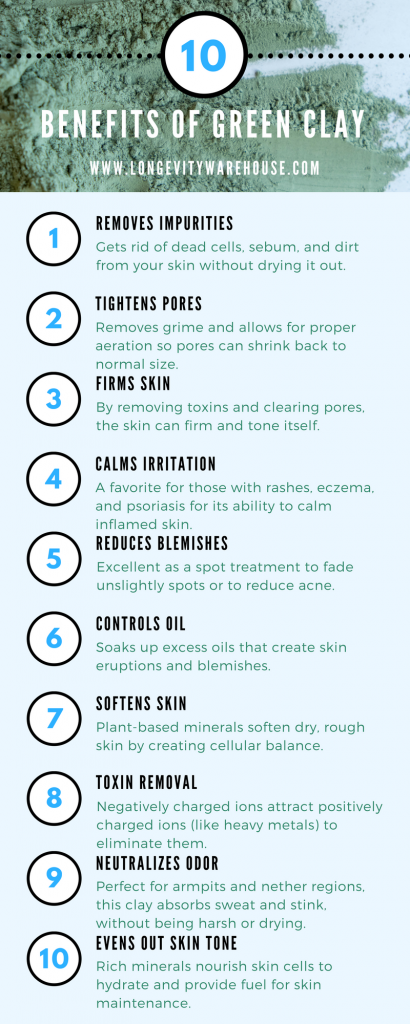
French Green Clay – Beauty Benefits
Long ago, our ancestors watched animals eating mud to help digest their food, and rolling in it to cleanse their skin and wounds. By mimicking the behavior of the beings around them, early humans discovered a beauty booster more powerful than anything created in a laboratory.
So was this incredibly valuable health and longevity tool really just mud? Well, not exactly. It was clay.
What is Clay?
Clay has withstood the test of time as nature’s best head-to-toe detoxifier.
It naturally occurs in the soil and sediment of our Earth and is richly made up of minerals like iron, silica, calcium, magnesium, and potassium – all the detoxifying, cell-supporting minerals your body loves. Our planet offers up different types of clays, and depending on the one you choose, it can detoxify internally, support your skin externally, or do both!
A natural “cleaner”, clay acts by drawing toxins to itself. Chemicals, heavy metals, and free radicals bind to the clay through the electrical charge created between the edges of the clay’s layers and the toxins. This pulls the toxins away from whatever surface they are on and absorbs them into the clay, which is then eliminated from the body.
Topically, clay has the ability to pull impurities from pores, boost skin elasticity, soothe allergic skin reactions, balance oil production, and even ease the effects of a sunburn. Internally, it can detoxify out nasty bacteria and other bugs from your digestive system. Clay has such drawing power that it has even been used in the environment alongside charcoal to help clean up toxic areas like Chernobyl.
Internal Use: Detoxification & Mineralization
Ever watch that kid next door making mud pies? She may be onto something other than just making a mess.
In America, we tend to freak out if our kiddo puts mud in his mouth, but in some countries, like the Philippines and Guatemala, mud pies are intentionally mixed up and eaten as part of a traditional way to get in healthy minerals. Pregnant woman in countries like Haiti, ingest clays while pregnant and lactating to ensure their babies don’t receive unnecessary toxins but do receive enough mineralized nutrition.
For detoxification purposes, clay is top notch:
- Native cultures of Central Africa and Australia carried dried balls of clay with them to shake into their water to purify it from bacteria.
- Aristotle reported people ingesting clay to stay healthy and drinking clay water with their meals to avoid food poisoning.
- Marco Polo wrote about watching Muslims eat “pink earth” to eliminate fevers.
- Alexander the Great’s soldiers, Roman soldiers, and soldiers during both World Wars were rationed clay to prevent and treat food poisoning, diarrhea, wound infections, and stave off hunger.
From handling digestive distress to actively removing heavy metals, chemicals, toxins, or other impurities from the mouth and gut, clay is an important part of natural detoxification and cleansing protocols.
Topical Use: Beauty Boosting Benefits
The same properties that make clay a fantastic internal detoxifier, make it a powerful topical skin aid. There is absolutely no need for chemical-filled soaps when you can wash your body with clay.
Clay facials, body wraps, baths, foot soaks have all been used throughout the centuries to purify, beautify, and refresh the skin. Recorded clay use for skin care dates back 3,000-4,000 years ago!
- One of the most beautiful women in history, Cleopatra, used clay taken from the Nile River and the Arabian desert as part of her skincare regime.
- Pliney the Elder wrote extensively about the use of clay to tighten up the skin and handle skin problems like pimples and blackheads.
- The spas in Rome and Germany offered clay packs and treatments to cleanse and rejuvenate their people.
Our modern day spas follow in the footprints of the past, offering extensive clay-based treatments. Many companies offer beauty products containing clay as its ability to cleanse and tone is unparalleled.
French Green Clay
Over time, French Green Clay has made its mark in the beauty world as one of the most gentle, yet powerful, for all skin types. Also called “Illite”, this pretty green clay has been used since the time of ancient Egypt, Greece, and Rome to enhance the tone and texture of the skin.
Its soft green color is created from a combination of mineral oxides and decomposed plant matter. Sea Clay is naturally high in iron oxide, magnesium, calcium, potassium, dolomite, silica, manganese, phosphorous, silicon, copper, selenium, iron, calcium, quartz, magnesium, and calcite. 
The magnitude of beauty uses for hair and skin include enhancing the complexion by calming inflammation, clearing dead skin cells, stimulating blood flow to the surface of the skin, minimizing the appearance of facial scars, evening out dark spots on the skin, repairing split ends, and cleaning the scalp. It is highly absorbent and an excellent way to tighten pores due to its micromolecules that drink up oils and impurities from your skin.
Many types of clays work so efficiently because their key minerals work together as a team, but French Clay is just the opposite. Its alchemical properties act in their own targeted ways to enhance your skin, which makes it such a special clay for beautification. It’s unique in that it can be used by everyone, as it doesn’t aggravate sensitive skin, but rather works gently to bring skin into balance.
Topical Benefits of French Green Clay
The Science of French Green Clay
Humankind has evolved in many major ways, including being able to scientifically analyze French green clay. The antibacterial properties were studied by Arizona State University where researchers found it to be effective in inhibiting Escherichia coli, Salmonella typhimurium, Pseudomonas aeruginosa, Staphylococcus aureus, and Mycobacterium marinum (bacterial pathogens that cause serious skin infections).
In another study, CsAg02, a specific mineral in the clay, showed marked antibacterial activity against not only the bacteria listed above but also penicillin-resistant S. aureus (PRSA), methicillin-resistant S. aureus (MRSA), and Mycobacterium smegmatis.
While most of us no longer sleep outside on the ground or hunt and gather for our food, one of the few things that remains unchanged from our humble beginnings is our use of clay. Utilizing French green clay as part of your skin care regimen is one of the easiest ways to cleanse, balance, and support your largest organ without subjecting it to harsh chemicals. We recommend the Longevity Warehouse® Clarifying Clay Bar Soap. Try it and see for yourself what centuries of people have determined to be the most effective natural cleanser available!
References:
https://www.ncbi.nlm.nih.gov/pmc/articles/PMC2413170/
St George, G. (2015) How Clay Works: Science and Applications of Clays and Clay-Like Minerals in Health and Beauty.
Carretero, MI, (2002) Clay minerals and their beneficial effects upon human health. Applied Clay Science (21), 155–163.
Price, Weston A. (2009). Nutrition and Physical Degeneration.
Bergaya, F, Theng, BKG, & Lagaly, G (2006) Handbook of Clay Science. Developments in Clay Science, Vol 1 (11), 117-125.




+ There are no comments
Add yours